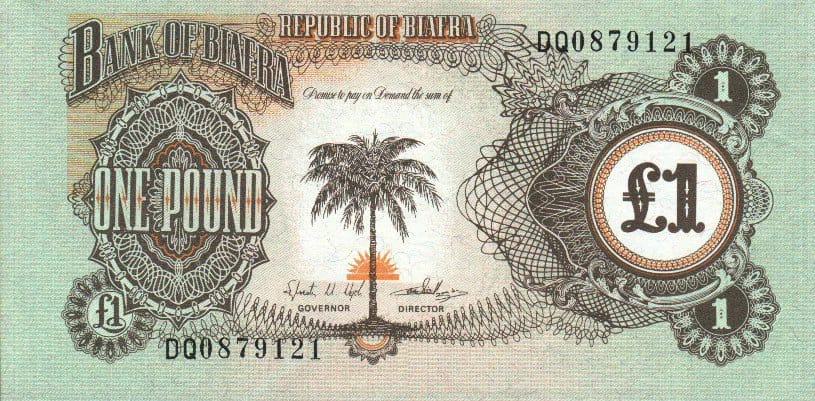In recent times, there has been a renewed agitation for the Republic of Biafra by members of the Movement for the Actualisation of Sovereign State of Biafra (MASSOB).
Nearly 50 years after the Biafran War (6 July 1967 – 15 January 1970) which almost destroyed the unity of Nigeria, its agitators have refused to give up the struggle.
This struggle by some Igbo people to secede from Nigeria started when on May 30, 1967, late Chukwuemeka Odumegwu Ojukwu, a military officer and politician announced a breakaway of the Eastern Region under the new name Republic of Biafra.
This subsequently sparked the Nigerian civil war also known as the Biafran war. The war was between the then Eastern Region of Nigeria and the rest of the country. The war was fought to reunify the country.
Below are some thing you should know about Biafra and the Biafran war.
1. Meaning of Biafra
Little is known about the literal meaning of the word Biafra. The word Biafra most likely derives from the subgroup Biafar or Biafada of the Tenda ethnic group who reside primarily in Guinea-Bissau. The word Biafar thus appears to have been a common word in the Portuguese language back in the 16th century. Biafra, a secessionist state in south eastern Nigeria is believed to have taken its name from the Bight of Biafra (the Atlantic bay to its south).
2. What caused the war
According to local and foreign war historians the immediate causes of the Nigeria civil war in 1966 included: a military coup (carried out by Maj. Nzeogwu which led to the death of Tafawa Belewa, etc), a counter-coup (led by Gowon, which led to the brutal murder of Aguiyi Ironsi, Fajuyi, etc) and the 1966 anti-Igbo pogrom in the north (persecution of Igbo people living in Northern Nigeria).
3. Over one million people died in the war
The war which lasted for 30 months took the lives of more than one million people. Some died in the battle while others were lost majorly through famine, and hunger. There were over 50,000 casualties of soldiers both from Biafran side and the Nigerian military.
4. The Biafran money

The Biafran money
The Biafran government created the Bank of Biafra, accomplished under “Decree No. 3 of 1967”. The bank was administered by a governor and four directors; the first governor, who signed on bank notes, was Sylvester Ugoh. They had their own currency different from that of Nigeria. The currency of Biafra had been the Nigerian pound, until the Bank of Biafra started printing out its own notes, the Biafran pound. The new currency went public on 28 January 1968. It is estimated that a total of £115–140 million Biafran pounds were in circulation by the end of the war.
The Nigerian Government at the end of the war ordered defeated Biafrans to destroy all their currencies.
5. Their national anthem
Land of the Rising Sun” was the proclaimed national anthem of the secessionist state of Biafra, in south-eastern Nigeria. The tune was adopted from Sibelius’ “Finlandia”, and written by Nnamdi Azikiwe.
6. The flag
A flag of red, black and green, horizontally, with a rising sun from the Coat of Arms (of the old Eastern Province) in gold in the centre was created by the Biafran Government and raised on May 30, 1967. The design and colours are based on the Pan-African flag designed by Marcus Garvey’s Union. The eleven rays of the sun represented the eleven provinces of Biafra.

The Biafran flag
The three Pan-African colors on the flag represent:
Red: the blood that unites all people of Black African ancestry, and shed for liberation;
Black: black people whose existence as a nation, though not a nation-state, is affirmed by the existence of the flag; and
Green: the abundant natural wealth of Africa.
7. States under Biafra
It constituted the former Eastern region of Nigeria and was inhabited principally by Igbo (Ibo) people. Biafra has been commonly divided into four main “tribes”: the Ibos, the Ibibio-Efiks, the Ijaws and the Ogojas. The modern-day states that made up Biafra from the eastern region and midwest are: Abia, Anambra, Akwa Ibom, Bayelsa, Enugu, Ebonyi, Imo, Delta, Rivers and Cross River and Edo.
8. How they got their arms and ammunitions
The Biafrans, through many of their people abroad, mounted a very strong campaign and propaganda for the recognition of Biafra by the international community and for the purchase of arms and equipment. Biafra was recognized by countries like, Tanzania, Zambia, Gabon, Ivory Coast, Haiti and Côte d’Ivoire.
However, Britain supplied amounts of heavy weapons and ammunition to the Nigerian side because of its desire to preserve the country it created.
9. How Nigerian military captured Biafran territories back
In March 1968, Onitsha fell to federal troops of the 2nd Infantry Division, after many bloody unsuccessful attempts. In April, Abakaliki was captured, followed in May by the fall of Port Harcourt to troops of the 3rd Marine Commando Division. Aba fell to federal forces on September 4th followed on September 16th by Owerri and Okigwe was taken on October 1st.
10. How the war ended
Biafran forces were finally routed in a series of engagements in late December 1969 and early January 1970. Realising that the situation was a hopeless one, Ojukwu handed over the administration of Biafra to the Commander Biafran Army Maj. Gen. Phillip Effiong. He then fled with his immediate family to Côte d’Ivoire. Effiong consulted with the Biafra Strategic Committee on the situation and they decided that enough was enough and that the only honorable way out was to surrender. Biafra, on the point of total collapse, surrendered and ceased to exist.











I’m commenting ‘cos you claim to present authentic African news. Unfortunately what you’ve written here are mostly skewed to your misinformation and it’s best admixture of crass error and half truths; shame on your inability to incorporate sound investigative journalism in your practice.